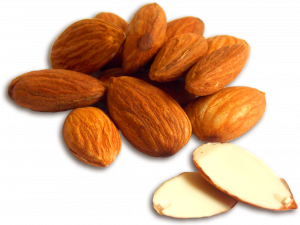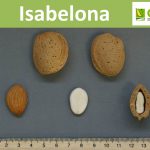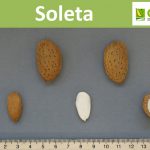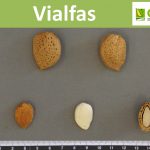 The breeding program has been carried on, releasing new cultivars in order to satisfy the quality requirements of the international market with compositional traits more adapted to the commercial and industrial determining factors, such as ‘Isabelona’ and ‘Soleta’, as well as very late blooming cultivars, such as ‘Diamar’ and ‘Vialfas’. All of them are self-compatible, without the need of cross pollination nor pollinating insects, and with a progressive ripening time allowing a gradual harvest.
The breeding program has been carried on, releasing new cultivars in order to satisfy the quality requirements of the international market with compositional traits more adapted to the commercial and industrial determining factors, such as ‘Isabelona’ and ‘Soleta’, as well as very late blooming cultivars, such as ‘Diamar’ and ‘Vialfas’. All of them are self-compatible, without the need of cross pollination nor pollinating insects, and with a progressive ripening time allowing a gradual harvest.
Almond research started in the present-day CITA de Aragón in 1964, with the incorporation of Dr. Antonio J. Felipe, when almond was not even considered as a fruit tree. Work during the first decade showed up that the problems of almond production in Spain were mainly due to two deficiencies: lack of a correct pollination and frost damages. This knowledge led to initiating a breeding program with two main objectives from the beginning in order to solve these problems: self-compatibility to overcome the pollination problems and late blooming in order to have cultivars blooming once the main frost risks were over.
The three first cultivars from this program were released in 1987, among them ‘Guara’, at present the reference cultivar in all the Spanish almond growing regions. This Cultivar blooms between February 26 and March 10, and ripens on average on August 23
 Tree: Medium vigor and semi-erect growth habit.
Tree: Medium vigor and semi-erect growth habit.
Flower: Blooms 3 days before ‘Guara’, with white flowers of medium-large size, mainly on spurs and less on mixed shoots. Good flower density.
Fruit: Ripening 16 days after ‘Guara’. Hard shell, without double layers, heart-shaped, shelling percentage of 27-35%, with the kernel filling the shell cavity. Large kernel, without double kernels, of roundish shape, very similar to ‘Marcona’, although slightly pointed and flatter, thus making blanching easier. Very good commercial aspect, and taste slightly sweet.
quality: Very high contents of oil and oleic acid in its composition, as well as of anti-oxidants, mainly tocopherols, thus resulting in one of the cultivars of extremely high quality.
 Tree: Medium vigor and slightly erect growth habit, very well adapted to high density planting.
Tree: Medium vigor and slightly erect growth habit, very well adapted to high density planting.
Flower: Blooms 3 days before ‘Guara’, with white flowers of medium-large size, mainly on spurs and less on mixed shoots. Very high flower density.
Fruit: Ripening 25 days after ‘Guara’. Hard shell, without double layers, of elliptical shape, shelling percentage of 27-35%, with the kernel filling the shell cavity. Large kernel, without double kernels, of elliptical shape, very similar to ‘Desmayo Largueta’, of very good commercial aspect.
quality: Of very easy seed coat removal after roasting and very good taste. Its composition shows average value for most components.
 Tree: Of very easy seed coat removal after roasting and very good taste. Its composition shows average value for most components.
Tree: Of very easy seed coat removal after roasting and very good taste. Its composition shows average value for most components.
Flower: Blooms 20 days after ‘Guara’, with white flowers of small size and epi-stigmatic pistil, both on spurs and mixed shoots. Average flower density, regular once the tree reaches a good productivity level.
Fruit: Ripening a week after ‘Guara’. Hard shell, without double layers, heart-shaped, pointed, shelling percentage of 24%. Medium kernel, without double kernels, of very good commercial aspect and very good taste.
quality: Its composition shows average value for most components, but the content in oleic acid is very high.
 Tree: Medium vigor and slightly erect growth habit, with tolerance to diseases.
Tree: Medium vigor and slightly erect growth habit, with tolerance to diseases.
Flower: Medium vigor and slightly erect growth habit, with tolerance to diseases.
Fruit: Ripening 9 days after ‘Guara’. Hard shell, heart-shaped, pointed, with slight double layers, shelling percentage of 25%. Medium to large kernel, without double kernels, of very good commercial aspect and good taste.
quality: Its composition shows average value for most components, but the content in oleic acid is extremely high.
More information: Download flyer in Repositorio citaREA